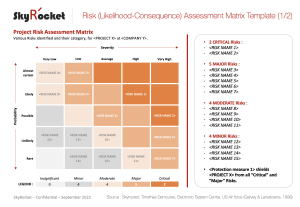
Risk Analysis models Start the discussion!

What are the types of risk?
The risk involved in these types of models can fall under four types of categories. Firstly, there is financial risk, which means the potential loss of money for shareholders, investors or stakeholders in a company. There are compliance risks as complying with certain regulations could lead to increased costs for a company. Furthermore, there are strategic risks which come from mergers, industry changes or research development. Finally, there are operational risks which come from a company’s administrative methods, like IT systems and recruitment. These risks can apply to not only businesses but also individual people, entities of the government or the financial market as a whole.
You can learn more about Financial risk (the most common kind), here.
What is risk analysis and how is it measured?
Risk analysis is the assessment of the likelihood of a problem occurring within a company or sector, which can be done by studying the precariousness of an action; it also refers to the uncertainty of forecasted cash flow streams, the variance of portfolio/stock returns, the probability of a project's success or failure, and possible future economic states.
The measurement of risk can be made by weighing the negative events that could happen against a probability metric to see how probable it is that it will happen. By doing this, the analyst can estimate the extent of the impact on the company or entity if the risk occurs.
You can learn more about Risk Analysis here.
Quantitative and Qualitative risk analysis
The two types of risk analysis are quantitative and qualitative. Models for quantitative risk analysis are made using simulation or statistics to put numerical values to the risk. Inputs that are mostly assumptions and random variables are fed into the risk model.
One of the most famous types of quantitative technique is the Monte Carlo simulation, which produces a range of possible outcomes from an action that has been taken. It does this by calculating a random set of input variables each time, which creates a probability distribution including all possible outcomes.
On the other hand, qualitative risk analysis uses text to measure the risk of a potential problem. This can include written definitions of the uncertainties, evaluations of the impact that could occur and possible methods to counter the negative effect of the risk in question. Examples of methods used to undertake a qualitative risk analysis are SWOT Analysis, Cause and Effect diagrams, Decision Matrix, and Game Theory.
Where can I find risk analysis models?
For companies or individuals looking to conduct a risk analysis of for their companies or themselves, the Eloquens catalogue has a variety of models designed and built by professionals. You can also build and self-publish your own model and template on Eloquens directly.
Most popular models
 Financial Analysis Template - 70 Financial Ratios to asses a companies financial health6038add_shopping_cart$110.00
Financial Analysis Template - 70 Financial Ratios to asses a companies financial health6038add_shopping_cart$110.00 by Fin-Wiser Advisory
by Fin-Wiser Advisory

Financial risks evaluation
Highlight and explain the financial risks of a revenue statement scenario.742Discussadd_shopping_cart$10.00

 by WMI Consulting
by WMI Consulting

Business Continuity Presentation
The Business Continuity Planning (BCP) template addresses the preservation and recovery of the business in the event of outages to normal business operations.243Discussadd_shopping_cart$15.00 by Muhammed Mohsin
by Muhammed Mohsin

Risk Tower
Risk Tower is a risk register Excel Sheet with a bubble graph218Discussadd_shopping_cart$6.00 by Jean-Philippe Borel
by Jean-Philippe Borel

Compute Incremental Risk Charge for a Bond Using Monte Carlo Simulation
A prototype to compute the incremental risk charge (IRC) for a bond position using a novel monte carlo simulation.7362add_shopping_cart$299.00 by Satish Ramanathan
by Satish Ramanathan

Risk (Likelihood-Consequence) Assessment Matrix Template
A project risk analysis matrix template in PowerPoint for project managers, business analysts to identify critical & major risks in need of protective measures.504Discussadd_shopping_cart$7.00
 by Tim Demoures
by Tim Demoures








